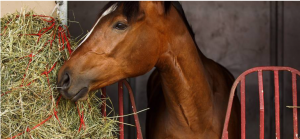 Haynet Height: Consider Comfort of Horses. Horsemanship masters and mavens of yesteryear taught their students to hang haynets high and tight. Low-slung haynets invited injury, the experts cautioned.
Haynet Height: Consider Comfort of Horses. Horsemanship masters and mavens of yesteryear taught their students to hang haynets high and tight. Low-slung haynets invited injury, the experts cautioned.
A resurgence in the use of haynets has occurred recently. Most frequently, as an attempt to slow hay consumption among horses on calorie-restricted diets. A high-tied haynet, however, encourages horses to crane their necks and contort their backs over a long period of time.
Habitual, unnatural postures can cause discomfort, even unsoundness. As a result, Italian researchers set out to determine the physical effects of haynet height on neck and back shape.*
Research:
“Horses and ponies seem to be quite specific in how they approach eating from a haynet,” said Catherine Whitehouse, M.S., a nutritionist with Kentucky Equine Research. “Some nibble from them, grasping pieces of hay carefully; some go in for large mouthfuls, aggressively yanking out hay. Others will headbutt the bag, leaving it swinging from its knot.”
Whatever their interaction with the haynet, Whitehouse said, changes in body position invariably occur and likely become a matter of routine.
In the study, researchers used geometric morphometrics to evaluate variations in neck and back shape relative to three specific hay-feeding positions.
Geometric morphometrics allows scientists to identify and analyze minute postural changes through the use of anatomical landmarks. Specifically, geometric morphometrics eliminates differences based on size and instead focuses on changes in shape of individuals. Hay was fed from three positions:
- Control position. The hay was fed from the ground.
- Low haynet position. The bottom of the haynet was level with the midpoint of the cannon bone.
- High haynet position. The bottom of the haynet was level with the elbow.
Researchers used slow-feed haynets made from high-density polyethylene twine. The haynet openings measured about 1.5 in (4 cm). 4.5 lb (2 kg) of the usual hay horses ate filled the haynets.
There were video recordings of six mature Warmbloods. Meanwhile, they ate hay from the three different feeding positions. While eating hay at each feeding position, horses were recorded for 15 minutes.. For example, using a cellphone placed on a tripod. Most importantly, this assured a consistent perspective.
Benefits:
Researchers found that feeding positions affected the shape of the neck and back postures during hay consumption.
Firstly, for individual horses, these changes in shape were well defined. With the low haynet position, the back posture more closely resembled that exhibited during the control position, indicating a more natural feeding position. However, the same was not true of neck posture. Both neck and back postures changed. Most considerably, hay offered in the high position. As a result, potentially leading to problems.
“Certain haynets and feeding devices designed to encourage slow consumption have refined the level of management that can be achieved when dealing with challenging horses. For example, the chronically overweight,” said Whitehouse.
“Even though the researchers identified some changes to neck and back shape, the long-term physical effects of feeding from haynets have not been studied. Right now, the benefits seem to outweigh the potential disadvantages.”
Horses on calorie-restricted diets require optimal nutrition, and this scenario calls for a well-formulated vitamin and mineral supplement, according to Whitehouse. “Because these horses are generally fed all-forage diets, they usually miss out on the vitamin and mineral fortification provided in concentrates. Therefore, an appropriate vitamin and mineral supplement can fill in the nutritional gaps left by forage.”
Safety First:
Most importantly, for safety’s sake: in the study described above, haynets were hung low under the watchful eye of professional scientists. In an everyday situation, whether it’s in a trailer or stall, haynets should be hung at a height safe for the individual horse. Lastly, the likelihood of a horse pawing and getting its hoof caught in the haynet decreases.
In conclusion, do you have a specific question about your horse’s health or hay diets? Contact J & J Hay Farms today at 770-887-0440!
Article Source: Kentucky Equine Research
*Raspa, F., A. Roggero, C. Palestrini, M.M. Canavesio, D. Bergero, and E. Valle. 2021. Studying the shape variations of the back, the neck, and the mandibular angle of horses depending on specific feeding postures using geometric morphometrics. Animals 11:763:11030763.
